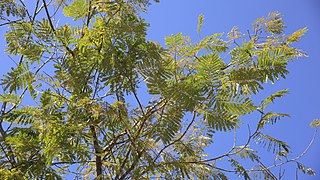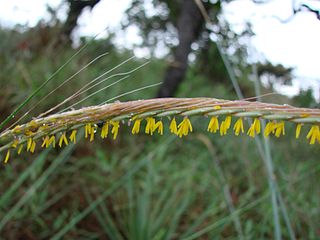
Desert Botanical Garden is a 140-acre (57 ha) botanical garden located in Papago Park, at 1201 N. Galvin Parkway in Phoenix, central Arizona.

The University of California Botanical Garden is a 34-acre botanical garden located on the University of California, Berkeley campus, in Strawberry Canyon. The garden is in the Berkeley Hills, inside the city boundary of Oakland, with views overlooking the San Francisco Bay. It is one of the most diverse plant collections in the United States, and famous for its large number of rare and endangered species.
The NatureServe conservation status system, maintained and presented by NatureServe in cooperation with the Natural Heritage Network, was developed in the United States in the 1980s by The Nature Conservancy (TNC) as a means for ranking or categorizing the relative imperilment of species of plants, animals, or other organisms, as well as natural ecological communities, on the global, national or subnational levels. These designations are also referred to as NatureServe ranks, NatureServe statuses, or Natural Heritage ranks. While the Nature Conservancy is no longer substantially involved in the maintenance of these ranks, the name TNC ranks is still sometimes encountered for them.

Lamium galeobdolon (gah-lay-OB-dough-lon), the yellow archangel, is a species of flowering plant in the mint family Lamiaceae. It is native to Europe and western Asia but it is widely introduced in North America and elsewhere. It is the only species in the genus Lamium with yellow flowers. Another common name for this species is golden dead-nettle. In New Zealand, it is called the aluminium plant or artillery plant. The common names archangel and dead-nettle have been in use for hundreds of years, dating back to at least the 16th century.
Staurogyne hirsuta is a species of plant native to Brazilian cerrado vegetation. It is a subshrub endemic to Minas Gerais state in southeastern Brazil. This plant is cited in Flora Brasiliensis by Carl Friedrich Philipp von Martius.
Staurogyne elegans is a species of flowering plant native to Brazilian cerrado vegetation. It is a subshrub or shrub native to Minas Gerais state. This plant is cited in Flora Brasiliensis by Carl Friedrich Philipp von Martius.

An IUCN Red List Critically Endangered species is one that has been categorized by the International Union for Conservation of Nature as facing an extremely high risk of extinction in the wild. As of December 2023, of the 157,190 species currently on the IUCN Red List, 9,760 of those are listed as Critically Endangered, with 1,302 being possibly extinct and 67 possibly extinct in the wild.

Leucochloron is a genus of flowering plant in the family Fabaceae. It includes four species native to Brazil. It belongs to the mimosoid clade of the subfamily Caesalpinioideae.

Echinolaena is a genus of plants in tribe Paspaleae of the grass family, native to the New World tropics. It includes only two species after the referral of former members to the related genera Hildaea, Ichnanthus, Oedochloa and the more distant Chasechloa in a 2015 revision.
Staurogyne bicolor is a species of plant in the family Acanthaceae. It is endemic to Cameroon. Its natural habitat is subtropical or tropical moist lowland forests. It is threatened by habitat loss.
Staurogyne sichuanica is a species of plant in the family Acanthaceae. It is endemic to China.
A Directory of Important Wetlands in Australia (DIWA) is a list of wetlands of national importance to Australia published by the Department of Climate Change, Energy, the Environment and Water. Intended to augment the list of wetlands of international importance under the Ramsar Convention, it was formerly published in report form, but is now essentially an online publication. Wetlands that appear in the Directory are commonly referred to as "DIWA wetlands" or "Directory wetlands".

Trachypogon is a small genus of African and Latin American plants in the grass family. Crinkleawn grass is a common name for plants in this genus.
Billbergia minarum is a plant species in the genus Billbergia. This species is native to Brazil.
Vriesea minarum is a plant species in the genus Vriesea. This species is native to Brazil.

Nelsonioideae is a subfamily of plants in the family Acanthaceae, with a pantropical distribution.
Paul Alfred Pételot (1885–1965) was a French botanist and entomologist, whose primary scholarly focus was on medicinal plants in Southeast Asia. Some sources list his date of death as 1940, but several herbaria specimens are recorded as being collected by him up until 1944 including Carex kucyniakii (1944), Teijsmanniodendron peteloti (1941), Amalocalyx microlobus (1941), Amalocalyx microlobus (1942), Trichosanthes kerrii (1944) and Siraitia siamensis (1944). In addition, he continued to author publications through the 1950s, though it is possible these are posthumous.
Oedochloa is a genus of flowering plants belonging to the family Poaceae.
Staurogyne repens is a plant in the family Acanthaceae, native to Brazil and Guyana. It was formally known as Ebermaiera repens. It is widely used as a tropical aquarium plant, where it grows as a bright green carpet at the bottom of the tank.







